|
The Atomic World
Most people accept that matter and energy is constructed from smaller parts. In classical physics we talk of atoms and electron orbits. Microscopy is the practice of studying things at higher and higher levels of magnifications to see more of the elementary components of the thing studied. We're a clever lot, humankind. The Greeks guesstimated over two thousand years ago the concept of large things being made from smaller indivisible components - atoms. They didn't get it quite right, because atoms also have
smaller parts, but wow, what a revelation. The human mind is often very intuitive as well as logical. If you start to bond atoms together, you make molecules. So, here's a sheet of them - molecules...
|
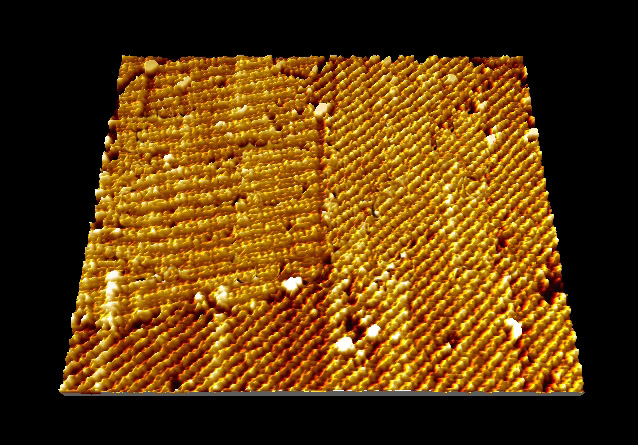
|
|
Scanning Tunnelling Microscope (STM) image of PTCDA molecules adsorbed on a Graphite surface. Author Frank Trixler, LMU/CeNS: Organic Semiconductor Nanostructures (wiki commons licence)
|
This images was captured using a Scanning Tunneling Microscope (STM), an instrument for imaging surfaces at the atomic level. For an STM, good resolution is considered to be 0.1 nm lateral resolution and 0.01 nm depth resolution. With this resolution, individual atoms within materials are routinely imaged and manipulated. The STM is based on the concept of quantum tunneling. When a conducting tip is brought very near to the surface to be examined, a bias (voltage
difference) applied between the two can allow electrons to tunnel through the vacuum between them. The resulting tunneling current is a function of tip position, applied voltage, and the local density of states of the sample.
Information is acquired by monitoring the current as the tip's position scans across the surface, and is usually displayed in image form. Extraordinary, that we can fun a finger over a surface, and 'feel' the texture so finely. Excuse my metaphor and analogy. If I were to explain how this image was achieved to someone in the middle ages, I might even remove the reference to finger and instead explain I had a special
wand which when run over the surface of something, informs me of its texture. I might lie and say I drew the picture.
Where was I? Oh yes. Atoms. We can manipulate them! Like this...
|
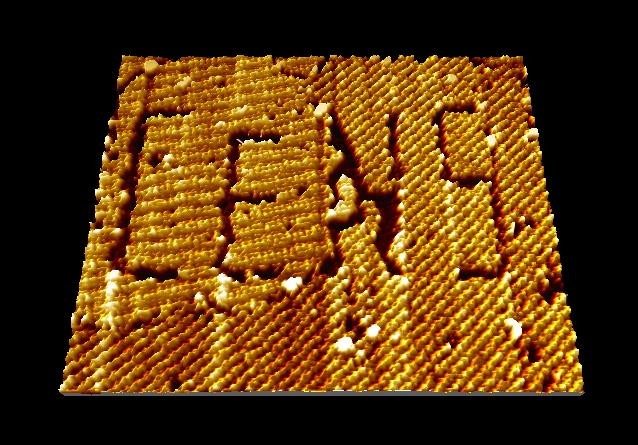
|
|
Nanomanipulation via STM of a self-assembled organic semiconductor monolayer (here: PTCDA molecules) on graphite, in which the logo of the Center for NanoScience (CeNS), LMU has been written. Author Frank Trixler, LMU/CeNS: Organic Semiconductor Nanostructures (wiki commons licence)
|
Neat aye? And real, not photo-shopped. It's bit like using a micro-chisel to carve out your name in a rock, or it will be just a few years from now when we will be nano-assembling molecules bottom up. But really, molecules and atoms is not the world I want to take you too. They are all a bit too big. I want to get small, small, small, right down to the quantum level so I can point a finger to where you really exist. What, you thought you were entirely here in
Macro world?
Well, you are but not every part of you. Not if you have a brain.
Oh dear... I'm going to wander. Why did I mention brain yet? Well, let's go there first.
Most of us are familiar with the brain's various functions. The one I am interested in here is computation or thinking. All the biological functions except for sensory perception to receive and store information is something else. Many people liken our brains to computers but nothing is further from the truth. Yes, there are several analogies which may help us understand how we 'think' but there is a very vital difference between a computer (most of the ones we currently use) and the processes going
on in our brain. To think, it seems you need a physical network where packets of information can be converted into chemical and electrical signals, in order they can sustain a complex web of intertwined charges to model a pattern. That pattern or web of electrical charges, is, in essence, at any given time - you! One might argue it is the locking together of chemicals related to those charges, which is the biological 'thought' you. But it isn't. Consciousness is fundamentally an electrical state rather than
a biological one although in humans and other animals, an interdependence exists between the two: You're not dead when the chemistry fails: you're dead when the electrical activity ceases.
But as we think more about certain things, the components of the brain (neurons, dendrites, and synaptic gaps) physically alter too. What you think, you become more fixed in. The biological brain shifts its physical pattern to enable quicker responses to repeated electrical stimuli. It creates new paths for information transfer, or shortens existing ones. It also brings into play more neurons to widen the 'processing' availability when you concentrate, or become deeply involved with a problem. Did you ever forget
to breathe while focused on something?
Anyway, these are the components that science currently acknowledges we think with...
|
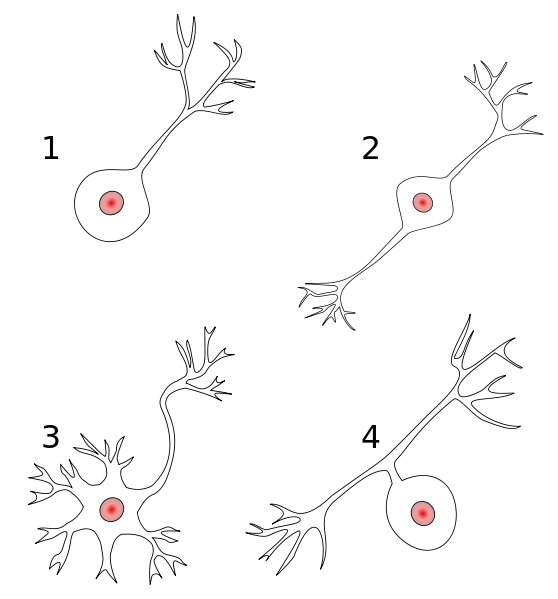
|
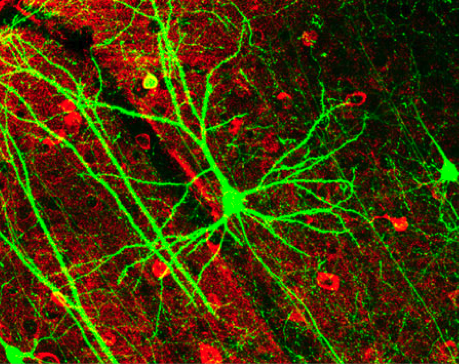 |
|
neurons drawing by Jonathan_Haas (wiki creative commons licence)
Different kinds of neurons:
1 Unipolar neuron
2 Bipolar neuron
3 Multipolar neuron4 Pseudounipolar neuron
|
Coronal section containing the chronically imaged pyramidal neuron “dow” (visualized by green GFP) does not stain for GABA (visualized by antibody staining in red). Confocal image stack, overlay of GFP and GABA channels. Scale bar: 100 μm (wiki creative commons licence through PLOS original copyright.
|
If you want a detailed account of how neurons work, an extensive read, it's worth going to the wiki page here to find out. But here is a brief summary from the wiki site along with a diagram.
A neuron or neurone or nerve cell is an electrically excitable cell that processes and transmits information through electrical and chemical signals. A chemical signal occurs via a synapse, a specialized connection with other cells. Neurons connect to each other to form neural networks. Neurons are the core components of the nervous system, which includes the brain, spinal cord, and peripheral ganglia. A number of specialized types of neurons exist: sensory neurons
respond to touch, sound, light and numerous other stimuli affecting cells of the sensory organs that then send signals to the spinal cord and brain. Interneurons connect neurons to other neurons within the same region of the brain or spinal cord.
|
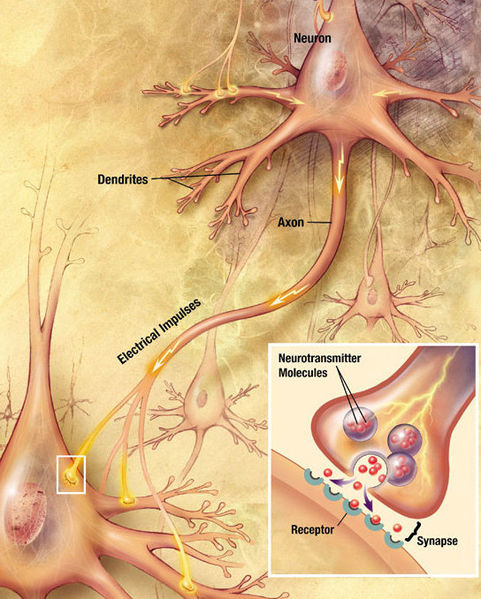
|
|
A typical neuron possesses a cell body (often called the soma), dendrites, and an axon. Dendrites are thin structures that arise from the cell body, often extending for hundreds of micrometres and branching multiple times, giving rise to a complex "dendritic tree". An axon is a special cellular extension that arises from the cell body at a site called the axon hillock and travels for a distance, as far as 1 meter in humans or even more in other
species. The cell body of a neuron frequently gives rise to multiple dendrites, but never to more than one axon, although the axon may branch hundreds of times before it terminates. At the majority of synapses, signals are sent from the axon of one neuron to a dendrite of another. There are, however, many exceptions to these rules: neurons that lack dendrites, neurons that have no axon, synapses that connect an axon to another axon or a dendrite to another dendrite, etc.
All neurons are electrically excitable, maintaining voltage gradients across their membranes by means of metabolically driven ion pumps, which combine with ion channels embedded in the membrane to generate intracellular-versus-extracellular concentration differences of ions such as sodium, potassium, chloride, and calcium. Changes in the cross-membrane voltage can alter the function of voltage-dependent ion channels. If the voltage changes by a large enough amount, an all-or-none electrochemical pulse called
an action potential is generated, which travels rapidly along the cell's axon, and activates synaptic connections with other cells when it arrives.
[This is an Extract from Wiki]
|
|
(wiki commons licence)
drawing illustrating the process of synaptic transmission in neurons
Source: www.nia.nih.gov Author US National Institutes of Health, National Institute on Aging
|
The part I am interested in is this. Is what we think only the result of information coming in through our physical senses, that information being added to other bits of information previously input and memorised, mixed and considered through various patterning (modelling) of it on our web of dendrites and neurons? And is what comes out or what appears fresh insights, ideas, intuitive thought, merely the result of a resolving function of only the input information?
In short, do we only have knowledge, thought, and action as a result of input from a physical world?
To simplify that, is the brain merely a computer - a Turin machine? Something where you can't get out more than what you put in, only input information reformed into re-patterned output data.
What do you think the answer is? Most people would agree with you if you said 'yes'. Information does not enter the brain (the mind) except through it's biological mechanism, and biological sensors the brain is connected to. Right?
Probably, that's wrong! Yes, I said wrong. I won't delight in it because for many years I thought that too. The trouble for me at a personal level is that I seem able to pick up information very rapidly, even when I haven't really studied it well. I don't always get it right, whatever it is I look into, but I kind of intuit lots of gaps as I go. It's almost like I already glimpsed the answer to something at the time I raised the question in my mind but before going to find out all the information to answer
my question.
If it were just that, I could probably think, the old brain is great at analogue computer and has simply jumped ahead without me being aware yet that it has already sparked up an area and sifted through a 63 year existence of holographically stored data and popped a generalised answer into my consciousness. That may well be happening but there may
also be another method of obtaining information from outside my stored knowledge and physical world.

Um... hold on a moment before you judge wrongly. On to the Quantum world. Stay with me. These two things, the brain, and the exotic physics of a quantum environment are both involved here.
|





